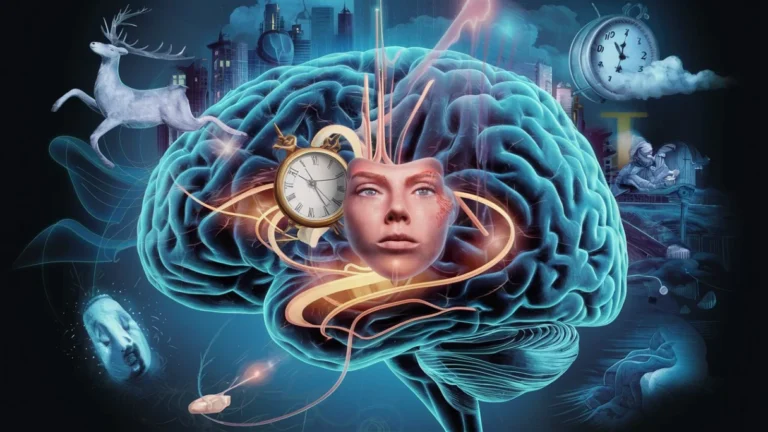The Science of Dreams: What Happens in Your Brain When You Sleep
Have you ever wondered what happens in your brain when you drift off to sleep and start dreaming? Dreams have fascinated humans for centuries, often leaving us puzzled, intrigued, or even frightened by their content. But what exactly is the science behind dreaming, and what occurs in our brains during this mysterious state? In this blog post, we’ll dive into the fascinating world of sleep and dreams https://dreamologyhub.com/, exploring the latest research and theories to help you better understand what goes on in your mind when you’re fast asleep.
The Sleep Cycle and REM Sleep
To understand dreams, we first need to look at the sleep cycle. Sleep is divided into two main categories: Non-Rapid Eye Movement (NREM) sleep and Rapid Eye Movement (REM) sleep. NREM sleep consists of three stages, each characterized by specific brain wave patterns:
- Stage 1: The transition from wakefulness to sleep, lasting only a few minutes.
- Stage 2: A deeper stage of sleep, with slower brain waves and occasional sleep spindles.
- Stage 3: The deepest stage of NREM sleep, also known as slow-wave sleep, characterized by delta waves.
After progressing through these stages, the sleep cycle enters REM sleep, which is when most dreaming occurs. During REM sleep:

- Your brain becomes highly active, resembling its state during wakefulness.
- Your eyes move rapidly behind closed lids, hence the name “Rapid Eye Movement.”
- Your body becomes paralyzed, preventing you from acting out your dreams.
A typical sleep cycle lasts around 90-120 minutes, with REM sleep occurring towards the end of each cycle. As the night progresses, REM periods become longer, with the final REM stage lasting up to an hour.
The Neuroscience of Dreaming
So, what exactly happens in your brain during REM sleep that leads to dreaming? Researchers have discovered several key brain regions and neurotransmitters involved in the dreaming process:
The Pons and REM Sleep Generation
The pons, a structure located in the brainstem, plays a crucial role in initiating and maintaining REM sleep. It contains specialized neurons that become active during REM sleep, sending signals to other parts of the brain involved in dreaming.
The Amygdala and Emotional Processing
The amygdala, an almond-shaped structure in the temporal lobe, is responsible for processing emotions. During REM sleep, the amygdala becomes highly active, which may explain why dreams often have a strong emotional content.
The Prefrontal Cortex and Dream Logic
The prefrontal cortex, located in the front of the brain, is involved in higher cognitive functions such as decision-making, planning, and logical reasoning. During REM sleep, the prefrontal cortex becomes less active, which may account for the often illogical and bizarre nature of dreams.
Neurotransmitters and Dream Content
Several neurotransmitters, including acetylcholine, norepinephrine, and serotonin, play a role in regulating the sleep-wake cycle and influencing dream content. For example:
- Acetylcholine levels increase during REM sleep, promoting vivid and emotionally charged dreams.
- Norepinephrine and serotonin levels decrease during REM sleep, which may contribute to the often surreal and disconnected nature of dreams.
Theories of Dream Function
While the neuroscience of dreaming is well-established, the purpose and function of dreams remain a topic of debate among researchers. Several theories have been proposed to explain why we dream:
Memory Consolidation
One prominent theory suggests that dreams play a role in memory consolidation, helping the brain process and store important information from the day. During sleep, the brain replays and strengthens neural connections associated with recent experiences, aiding in the transfer of information from short-term to long-term memory.
Emotional Regulation
Another theory proposes that dreams serve an emotional regulation function, allowing the brain to process and cope with strong emotions experienced during wakefulness. By “rehearsing” emotional situations in a safe, dreamlike environment, the brain may help reduce the emotional impact of stressful or traumatic events.
Problem Solving and Creativity
Some researchers believe that dreams may facilitate problem-solving and boost creativity. The unique neurochemical environment of REM sleep, combined with the lack of logical constraints, may allow the brain to make novel connections and generate innovative ideas. Many famous inventors, artists, and scientists have credited dreams with inspiring their groundbreaking works.
Evolutionary Perspective
From an evolutionary standpoint, dreams may have served as a form of “threat simulation,” allowing our ancestors to practice and prepare for dangerous situations in a safe, virtual environment. This theory suggests that dreams may have enhanced survival by improving an individual’s ability to react to real-life threats.
Lucid Dreaming: Taking Control of Your Dreams
Lucid dreaming is a fascinating phenomenon in which the dreamer becomes aware that they are dreaming and can often exert control over the dream content. Lucid dreams occur most frequently during REM sleep and are associated with increased activity in the prefrontal cortex, suggesting heightened self-awareness and metacognition.
Techniques for inducing lucid dreams include:
- Reality checks: Regularly questioning whether you’re awake or dreaming throughout the day can help you recognize when you’re in a dream.
- Dream journaling: Writing down your dreams immediately upon waking can increase dream recall and awareness.
- Mnemonic induction of lucid dreams (MILD): Set an intention to remember that you’re dreaming before going to sleep, and upon waking, remind yourself that you’ll recognize when you’re dreaming.
Lucid dreaming has garnered interest from both the scientific community and the general public, with potential applications in areas such as nightmare treatment, skill rehearsal, and creative problem-solving.
Conclusion
The science of dreams is a captivating field that continues to unravel the mysteries of the sleeping brain. By understanding the neuroscience behind dreaming, the theories of dream function, and the potential for lucid dreaming, we can gain a deeper appreciation for the complex and enigmatic world of our dreams.
As research progresses, we may uncover even more fascinating insights into the purpose and mechanisms of dreaming. Until then, we can marvel at the incredible ability of our brains to create vivid, emotional, and often bizarre dream experiences while we sleep, and perhaps even learn to harness the power of our dreams for personal growth and well-being.




